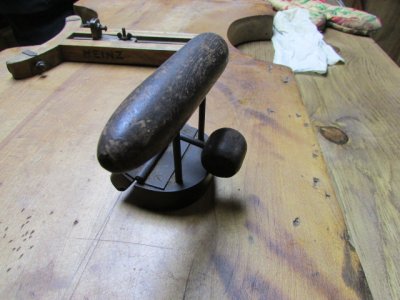Want to buy or sell something? Check the classifieds
-
The Fedora Lounge is supported in part by commission earning affiliate links sitewide. Please support us by using them. You may learn more here.
You are using an out of date browser. It may not display this or other websites correctly.
You should upgrade or use an alternative browser.
You should upgrade or use an alternative browser.
Photos of hatters tools
- Thread starter airforceindy
- Start date
Yes, that's the cause of the green bulge, often seen in the back of vintage hats.
Google is your friend
Verdigris:

Miamibruno
One Too Many
- Messages
- 1,018
- Location
- Milton, MA
JG - Thanks for posting the picture of the rounding jack et. al. Very cool stuff.
I do have a question about the hatter's irons: aren't they curved? The hatter's irons I've seen are curved to go around the crown. Do the ones pictured work as well?
I do have a question about the hatter's irons: aren't they curved? The hatter's irons I've seen are curved to go around the crown. Do the ones pictured work as well?
humanshoes
One Too Many
- Messages
- 1,446
- Location
- Tennessee
Thanks, Hatter4. Boiled linseed oil it will be. I would be a fool to disregard your knowledge and experience in these matters.
JG - Thanks for posting the picture of the rounding jack et. al. Very cool stuff.
I do have a question about the hatter's irons: aren't they curved? The hatter's irons I've seen are curved to go around the crown. Do the ones pictured work as well?
Well, you'd better brace yourself for a brain dump of what I've learned on the subject (which may well be corrected or enlarged upon by those who know more).
Sad irons represented real and every day practical technology at the time and they were made and were used for many different tasks. Some were true flat irons used for clothing, but there also were crimping irons, sleeve irons, collar irons, tailor's irons, etc .
The foot irons and shackles are certainly curved to match the crown & brim of a hat, respectively and as such are more easily identified as hatter's irons and are usually prohibitively priced.
There are other hatter's irons that were not curved in the way you mean, however, including polishing irons.
In addition to foot irons (tollikers) used to make a good crisp junction between the crown and brim (the "foot"), a hatter's set of irons usually included convex (rounded) bottomed irons for doing brims, and concave (inverted curve) for doing crowns, as well as flat irons.
Fellows like Oliver (Hatter4) who made stiff felt hats also had edge irons and another long handled iron (that I can't recall the name of right now but which vaguely resembles an old soldering iron) for doing fine brim work under a D'Orsay curl.
Small-bodied sad irons with rounded edges and full sized handles are often actually hatter's irons rather than toy irons, which have small child-sized handles. The ones I found today are like that, but they are also a little bit round (convex) bottomed.
Hatter's irons are usually small- bodied and often have either rounded edges and bottoms, or convex bottoms. These are different from flat irons with sharper points (like a pentagon shaped tailor's iron) that were used for pressing clothes, but they are still "sad" irons (why they are called this is a whole 'nother topic).
If you look back in this thread you will see the Mahoney (marked Troy) polishing hatter's iron that is not curved front to back, but has a rounded front and convex bottom and Hatter4's rare (awesome) concave-bottomed crown iron, as well as my little oval flat hatter's iron, and some tear-drop shaped hatter's irons - along with a bundle of others that I posted from a sad iron website a while back - in addition to the curved foot tollikers.
Hatters were practical people though and they did use true toy irons. By way of example, Ermatinger specifically advises using a "toy iron" when he describes how to make a telescope crown.
The difference between a true hatter's sad iron and a child's toy sad iron is generally the handle size as far as I can tell, but many working hatter's estate sale collections do include at least one true toy sad iron, meant for a child to play with (imagine that!). I've even seen electric toy sad irons, which were actually probably safer.
If you watch eBay you will note that when a working hatter's collection is sold it often includes a small (Potter's I believe) football-shaped asbestos iron that is a true toy sad iron. I'm sure that like Ermatinger, they found them available and useful.
The American Hatter is a great resource for ads for hatter's irons. I am no sad iron expert, but I have spent significant time researching this topic.
The Mahoney polishing iron (marked "Troy" because it was made there) and knock offs are specifically listed as hatter's irons in such ads, but are rarely identified as such when sold online, except by sad iron collectors. If you get one from a sad iron collector you'll pay hatter's iron prices (ouch), but you can find them on eBay and elsewhere at very decent prices. There are a few listed on eBay right now.
This is all a bit semantic and collector-oriented though. As Olė noted a while back, his best "hatter's iron" is a good electric steam iron ;-).
I have a collecting bug and like the idea of using the old school hatter's tools and methods. I get a kick out of that, and aspire to have and use a collection like Hatter4's someday, so I probably overdo it when it comes to sad irons. Although it is romantic to use the old tools, we should also recognize modern improvements.
I am reminded of Ishi (I live near his stomping grounds) who used glass & nails to make his tools because they were better than stones.
The bottom line is to use what works, as Ermatinger implicitly suggested when he referred to the "toy iron."
Last edited:
bloc
One of the Regulars
- Messages
- 199
- Location
- Llandovery, Wales, UK
OH NO!! Feeling depressed...
http://www.ebay.co.uk/itm/Adorable-...D&orig_cvip=true&rt=nc&_trksid=p2047675.l2557
http://www.ebay.co.uk/itm/Adorable-...D&orig_cvip=true&rt=nc&_trksid=p2047675.l2557
bloc
One of the Regulars
- Messages
- 199
- Location
- Llandovery, Wales, UK
We're thinking about making a sandbag too. Be interested in your progress. We may be moving premises so will hold fire for now.Thanks Hatter4. I was wondering if it was for creating a recess for the reed to rest in after it is flared. I'm not getting the reeds to set down as nice as I would like, although they flare ok. Any tips are appreciated.
I'm thinking about making a sandbag. Maybe I should have bought that flanging tool above, which just sold on eBay.
bloc
One of the Regulars
- Messages
- 199
- Location
- Llandovery, Wales, UK
Hear hear, the information you guys share here is priceless. I am very grateful. And the Tumwater Hat Co blog is a great resource, thanks John for the heads up. You should add your name to the list of fine contributors for your generous sharing of your trials and successes.He told me the same thing. I (carefully) use the cutter on a pair of needle nose pliers to do this.
------------------------------------------
Caveat - Long, boring slightly preachy & self indulgent rant follows:
------------------------------------------
While I'm on my soapbox, I'll take this opportunity to thank the proprietor of Tumwater Hat Co. (I don't know his name, which kind of supports my point) for his brim binding tutorial - referred to me by buddy Terry Jones:
http://tumwaterhatco.tumblr.com/page/5
I wish I could contribute more myself, all I have are questions and I'm a little short of time, three small boys and a hat business to run.
I did use a great pattern cutting tutorial yesterday for making hat linings. I will post details of the book I used. Might be helpful for someone.
bloc
One of the Regulars
- Messages
- 199
- Location
- Llandovery, Wales, UK
Returning to theme a bit, with the heavy "Canton" flanging felt (I hope) that I purchased on eBay. I went with natural. Auction photo. Beats the unnamed hatter's price by tens of dollars a yard.

"FABULOUS THICK CANTON Flannel backed Twill Natural & White Fabric 100% cotton[natural on natural]"
http://bit.ly/1h5hZgO
Having a lot of difficulty finding canton flannel here in the UK (and yes, I saw the ebay listing you refer to John and gave that a miss). Is there a British term for it?
bloc
One of the Regulars
- Messages
- 199
- Location
- Llandovery, Wales, UK
Ah, a swizzle stirrer, better get myself out for a cocktail and have a look.
bloc
One of the Regulars
- Messages
- 199
- Location
- Llandovery, Wales, UK
Thanks to John and Ole for the verdigris info. Still in experimental phase. Will try and get hold of the steel roll pins for the commission hats which will hopefully last long enough to warrant them.
bloc
One of the Regulars
- Messages
- 199
- Location
- Llandovery, Wales, UK
There is a very useful tutorial on paper pattern making for hat linings in this book
http://www.amazon.co.uk/Fashion-Hats-Design-Karen-Henriksen/dp/071368738X
Don't know if it is available in the US.
Some of you may even be tempted into the world of millinery??
http://www.amazon.co.uk/Fashion-Hats-Design-Karen-Henriksen/dp/071368738X
Don't know if it is available in the US.
Some of you may even be tempted into the world of millinery??
Hatter4
One of the Regulars
- Messages
- 226
- Location
- East Petersburg, PA
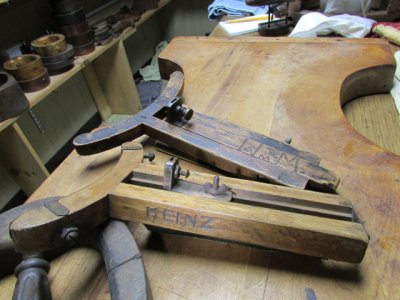 What I find interesting with the old tools, is when you find the name of the manufacturer on the old tools. But it is also even more interesting when you find the name of the person who owned the tool--as shown in these two rounding jacks. The one that says WmM was made by a company called Albert Cortier, Newark, NJ. The other one just says Heinz. I have 6 rounding jacks but these are the most interesting.
What I find interesting with the old tools, is when you find the name of the manufacturer on the old tools. But it is also even more interesting when you find the name of the person who owned the tool--as shown in these two rounding jacks. The one that says WmM was made by a company called Albert Cortier, Newark, NJ. The other one just says Heinz. I have 6 rounding jacks but these are the most interesting.Hatter4
One of the Regulars
- Messages
- 226
- Location
- East Petersburg, PA
TheDane
Call Me a Cab
- Messages
- 2,670
- Location
- Copenhagen, Denmark
Sad irons represented real and every day practical technology at the time and they were made and were used for many different tasks. Some were true flat irons used for clothing, but there also were crimping irons, sleeve irons, collar irons, tailor's irons, etc . [...]
John, I think we're in agreement, but I don't like your use of "concave" and "convex". The outside of a drinking glass is convex - while the inside is concave. A convex surface "bulges" outward, while a concave "bulges" inward. I think, this is what you mean:
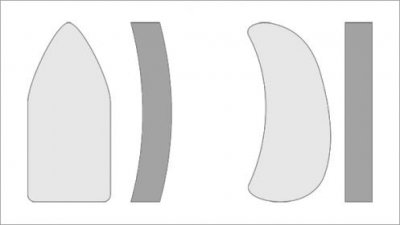
- where the left is used for the crown, and the right is used on the brim - primarily to set a crisp bandline. Sorry, I couldn't find Mr. Rembrandt, so I made a very quick mock-up in Illustrator
PS: When it comes to the age of my tools, then I prefer modern quality tools - just like I would not choose a car, running on steam. Passively heated irons were, what was possible/available 100 years ago. Hatters at that time would have loved an electrically heated iron with thermostat. Of course they would never choose the crap, they were using, had they had the choise. My dad worked as a conservator at a museum, but my approach to hatting is another. I just like to fool around with making hats as well as I can (= the best available tools) - but I do like to have some antique tools standing on a shelf. My fun is the hat-making itself - not the reenacting of a working historic hatter's shop.
Last edited:
- Messages
- 17,716
- Location
- Maryland
Johann Hückel´s Söhne factory early 1900s
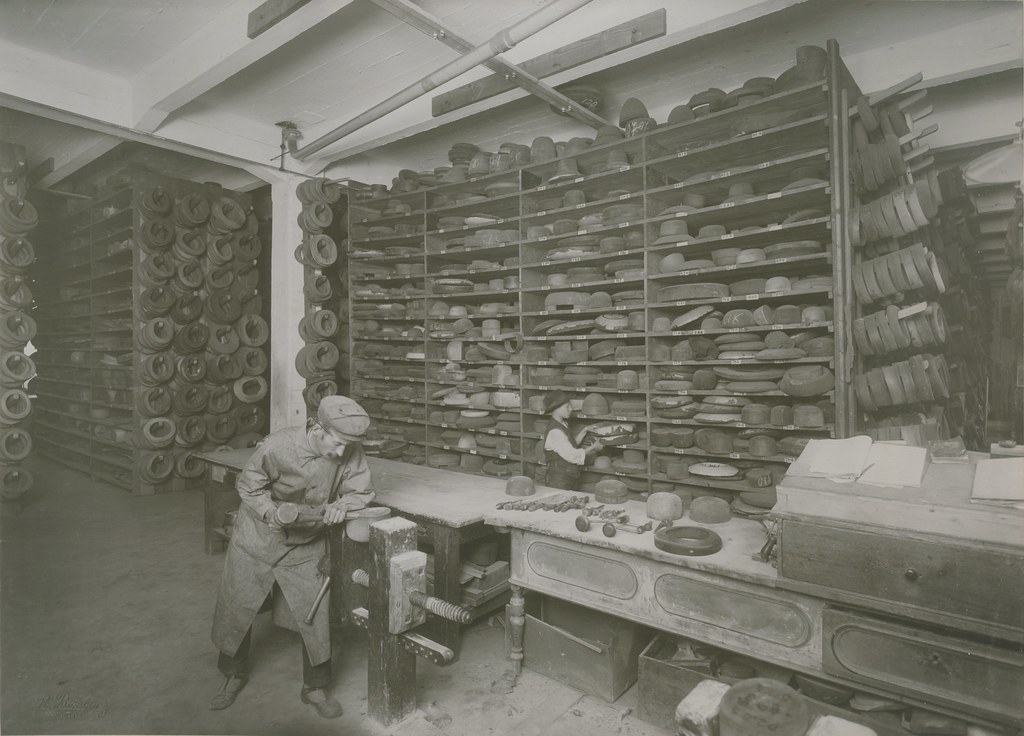
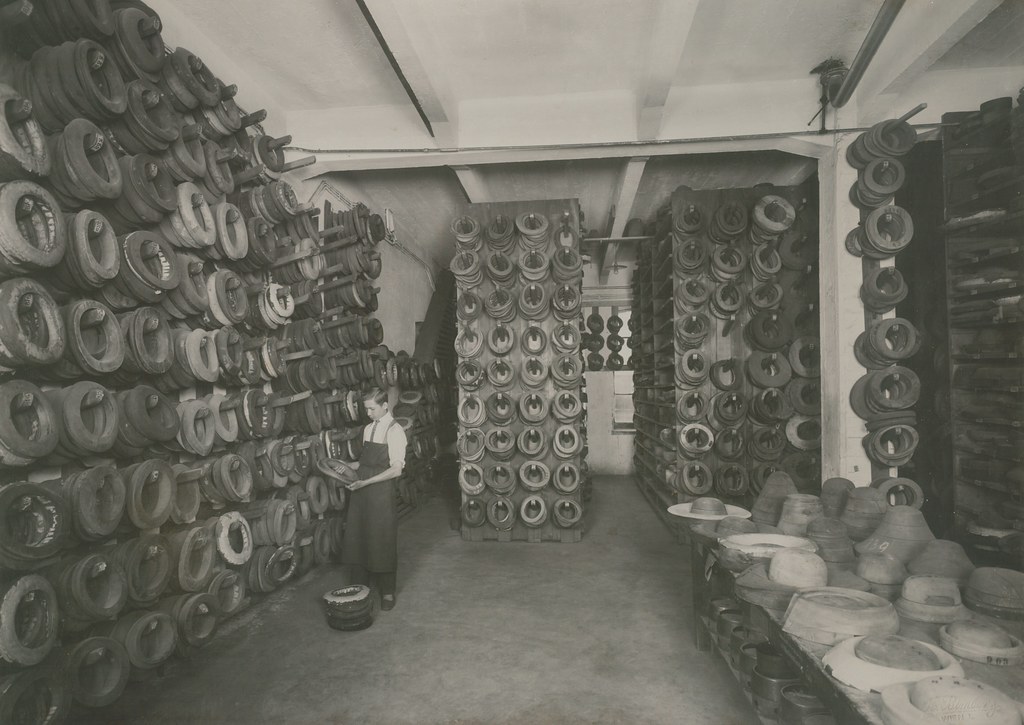
They still have a lot of the old stuff (this is a big factory) but it is no longer in use.


They still have a lot of the old stuff (this is a big factory) but it is no longer in use.
Last edited:
TheDane
Call Me a Cab
- Messages
- 2,670
- Location
- Copenhagen, Denmark
Steve, that's not a way to treat junkies! lol
- Messages
- 17,716
- Location
- Maryland
Much of it's still there. The last of its kind.
TheDane
Call Me a Cab
- Messages
- 2,670
- Location
- Copenhagen, Denmark
I really should visit the place someday! Not that far away
You should add your name to the list of fine contributors for your generous sharing of your trials and successes.
I wish I could contribute more myself, all I have are questions and I'm a little short of time, three small boys and a hat business to run.
I did use a great pattern cutting tutorial yesterday for making hat linings. I will post details of the book I used.
Thanks, but I'm just another hat lover trying to learn as much as I can and give something back to the forum that's taught me so much.
The Tumwater blog was recommended by my buddy Terry Jones, I just passed it on.
I am looking forward to the liner tutorial!
Featured products
-
 John Lofgren Monkey Boots Shinki Horsebuttt - $1,136 The classic monkey boot silhouette in an incredibly rich Shinki russet horse leather.
John Lofgren Monkey Boots Shinki Horsebuttt - $1,136 The classic monkey boot silhouette in an incredibly rich Shinki russet horse leather. -
 Grant Stone Diesel Boot Dark Olive Chromexcel - $395 Goodyear welted, Horween Chromexcel, classic good looks.
Grant Stone Diesel Boot Dark Olive Chromexcel - $395 Goodyear welted, Horween Chromexcel, classic good looks. -
 Schott 568 Vandals Jacket - $1,250 The classic Perfecto motorcycle jacket, in a very special limited-edition Schott double rider style.
Schott 568 Vandals Jacket - $1,250 The classic Perfecto motorcycle jacket, in a very special limited-edition Schott double rider style.
Similar threads
- Replies
- 8
- Views
- 6K
- Replies
- 18
- Views
- 12K
- Replies
- 23
- Views
- 9K


